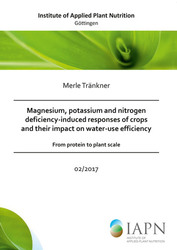| Departments | |
|---|---|
| Book Series (96) |
1379
|
| Nachhaltigkeit |
3
|
| Gesundheitswesen |
1
|
| Humanities |
2367
|
| Natural Sciences |
5407
|
| Mathematics | 229 |
| Informatics | 319 |
| Physics | 980 |
| Chemistry | 1364 |
| Geosciences | 131 |
| Human medicine | 243 |
| Stomatology | 10 |
| Veterinary medicine | 108 |
| Pharmacy | 147 |
| Biology | 835 |
| Biochemistry, molecular biology, gene technology | 121 |
| Biophysics | 25 |
| Domestic and nutritional science | 45 |
| Agricultural science | 1004 |
| Forest science | 201 |
| Horticultural science | 20 |
| Environmental research, ecology and landscape conservation | 148 |
| Engineering |
1793
|
| Common |
98
|
|
Leitlinien Unfallchirurgie
5. Auflage bestellen |
|
Advanced Search
Magnesium, potassium and nitrogen deficiency-induced responses of crops and their impact on water-use efficiency - from protein to plant scale - (Volume 2) (English shop)
Merle Tränkner (Author)Preview
Table of Contents, PDF (41 KB)
Extract, PDF (100 KB)
The world’s population reached 7.3 billion in 2015 and according to the United Nations, the world’s population will continue to grow by 1.18 % per year, projected to reach 8.5 billion in 2030 and 9.7 billion in 2050 (United Nations, 2015). Consequently, global demand for food is steadily rising and exerts a pressure on the need for more efficient crop production. However, efficient crop production is hampered by biotic and abiotic stress factors, such as drought. Drought poses the most important limitation to crop productivity in the world (Lauer et al. 2012) and increases in the frequency and intensity of drought events are predicted (Pachauri and Meyer 2014).
| ISBN-13 (Hard Copy) | 9783736995369 |
| ISBN-13 (eBook) | 9783736985360 |
| Final Book Format | A5 |
| Language | English |
| Page Number | 134 |
| Edition | 1. |
| Book Series | Institute of Applied Plant Nutrition - Göttingen |
| Volume | 2 |
| Publication Place | Göttingen |
| Place of Dissertation | Göttingen |
| Publication Date | 2017-05-12 |
| General Categorization | Dissertation |
| Departments |
Agricultural science
Plant production |
| Keywords | Magnesium, potassium and nitrogen, deficiency-induced |








